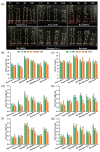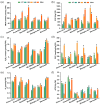Effects of Combined Salt and Heat Stress on Agronomic Traits, Photosynthetic Parameters, and Physiological Biochemistry in Six Alfalfa (Medicago sativa L.) Cultivars
- PMID: 40872102
- PMCID: PMC12389436
- DOI: 10.3390/plants14162479
Effects of Combined Salt and Heat Stress on Agronomic Traits, Photosynthetic Parameters, and Physiological Biochemistry in Six Alfalfa (Medicago sativa L.) Cultivars
Abstract
Climate change due to global warming increases the susceptibility of plants to multiple combined stresses. Soil salinization and high temperature stresses that co-occur in arid/semiarid regions severely restrict the growth and development of plants. Although alfalfa (Medicago sativa L.) is an important forage grass, the physiological mechanisms driving its responses to combined salt and heat stress are not yet clear. This study aimed to reveal the physiological and biochemical response mechanisms of six alfalfa cultivars to different stresses by comparing plant morphology, agronomic traits, photosynthetic characteristics, and physiological and biochemical responses under control conditions, salt stress (200 mM NaCl), heat stress (38 °C), and combined salt and heat stress. Compared with single stresses, combined stress significantly inhibited the growth and biomass accumulation of alfalfa. Under combined stress, the cultivars presented decreases in plant height and total fresh biomass of 11.87-26.49% and 28.22-39.97%, respectively, compared with those of the control plants. Heat stress promoted alfalfa photosynthesis by increasing stomatal conductance, net photosynthetic rate, and transpiration rate, while salt stress and combined stress significantly suppressed these effects. Combined stress significantly increased the concentration of Na+ but decreased that of K+ and the relative water content in alfalfa leaves. Compared with the control and single stress treatments, combined stress significantly increased the level of membrane lipid peroxidation and accumulation of reactive oxygen species. The proline contents in the leaves of the different alfalfa cultivars were 2.79-11.26 times greater under combined stress than in the control. Combined stress causes alfalfa to redistribute energy from growth and development to stress defense pathways, ultimately leading to a reduction in biomass. Our study provides theoretical guidance for analyzing the mechanisms of grass resistance to combined salt and heat stress.
Keywords: Medicago sativa; combined salt and heat stress; photosynthesis; plant growth.
Conflict of interest statement
The authors declare no conflicts of interest.
Figures








Similar articles
-
Melatonin-Producing Bacillus aerius EH2-5 Enhances Glycine max Plants Salinity Tolerance Through Physiological, Biochemical, and Molecular Modulation.Int J Mol Sci. 2025 Aug 13;26(16):7834. doi: 10.3390/ijms26167834. Int J Mol Sci. 2025. PMID: 40869153 Free PMC article.
-
Seed-Borne Erwinia persicina Affects the Growth and Physiology of Alfalfa (Medicago sativa L.).Front Microbiol. 2022 May 26;13:891188. doi: 10.3389/fmicb.2022.891188. eCollection 2022. Front Microbiol. 2022. PMID: 35694312 Free PMC article.
-
Wheat Straw Biochar Amendment Increases Salinity Stress Tolerance in Alfalfa Seedlings by Modulating Physiological and Biochemical Responses.Plants (Basel). 2025 Jun 26;14(13):1954. doi: 10.3390/plants14131954. Plants (Basel). 2025. PMID: 40647963 Free PMC article.
-
Understanding abiotic stress in alfalfa: physiological and molecular perspectives on salinity, drought, and heavy metal toxicity.Front Plant Sci. 2025 Jul 31;16:1627599. doi: 10.3389/fpls.2025.1627599. eCollection 2025. Front Plant Sci. 2025. PMID: 40822732 Free PMC article. Review.
-
Active body surface warming systems for preventing complications caused by inadvertent perioperative hypothermia in adults.Cochrane Database Syst Rev. 2016 Apr 21;4(4):CD009016. doi: 10.1002/14651858.CD009016.pub2. Cochrane Database Syst Rev. 2016. PMID: 27098439 Free PMC article.
References
-
- Zhou R., Yu X.Q., Kjaer K.H., Rosenqvist E., Ottosen C.O., Wu Z. Screening and validation of tomato genotypes under heat stress using Fv/Fm to reveal the physiological mechanism of heat tolerance. Environ. Exp. Bot. 2015;118:1–11. doi: 10.1016/j.envexpbot.2015.05.006. - DOI
Grants and funding
LinkOut - more resources
Full Text Sources

